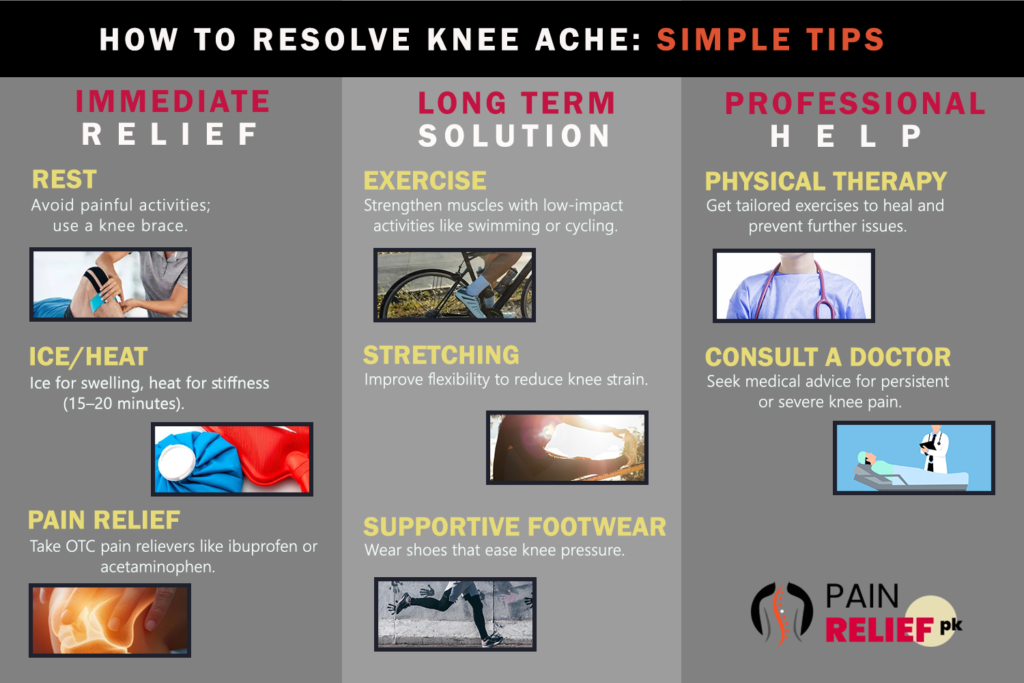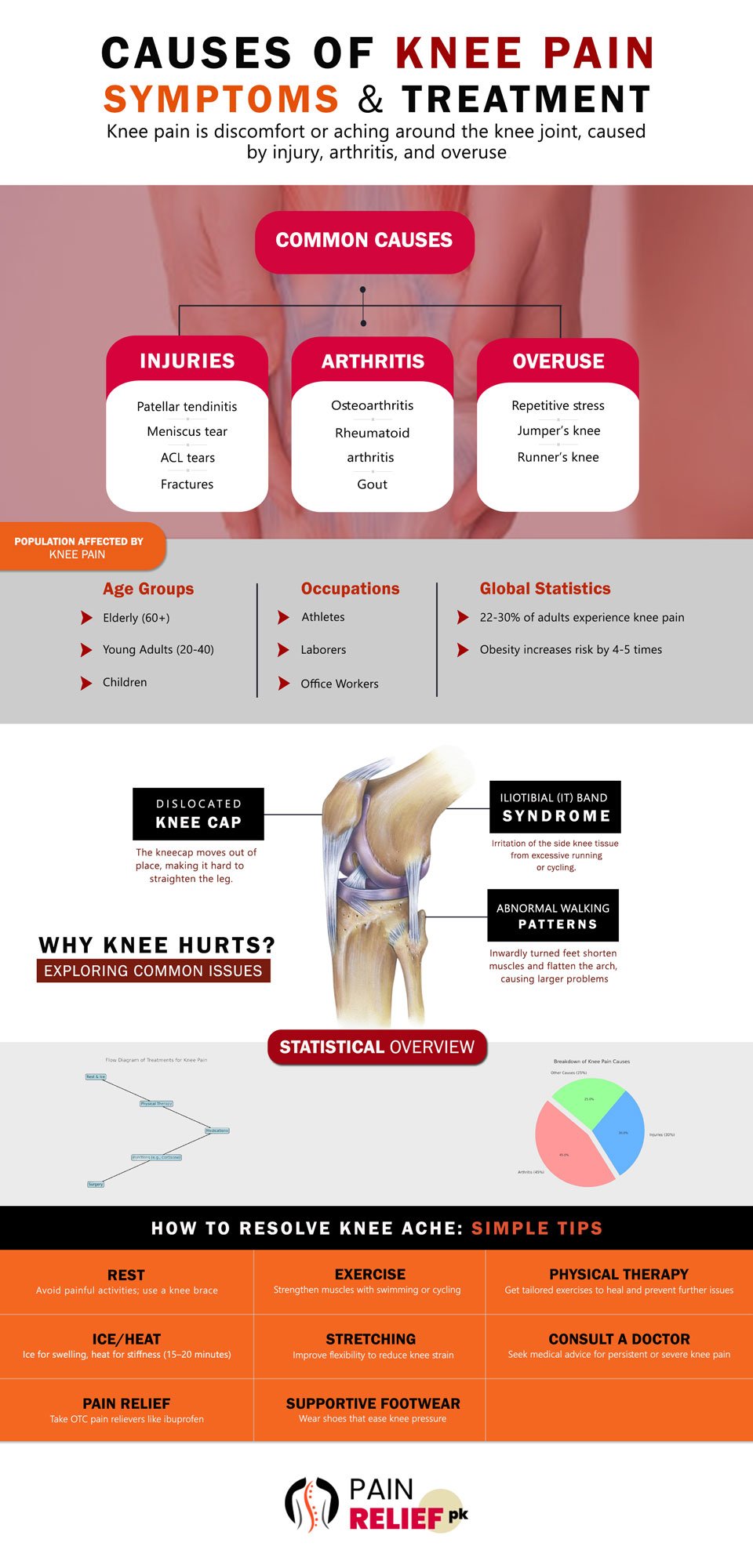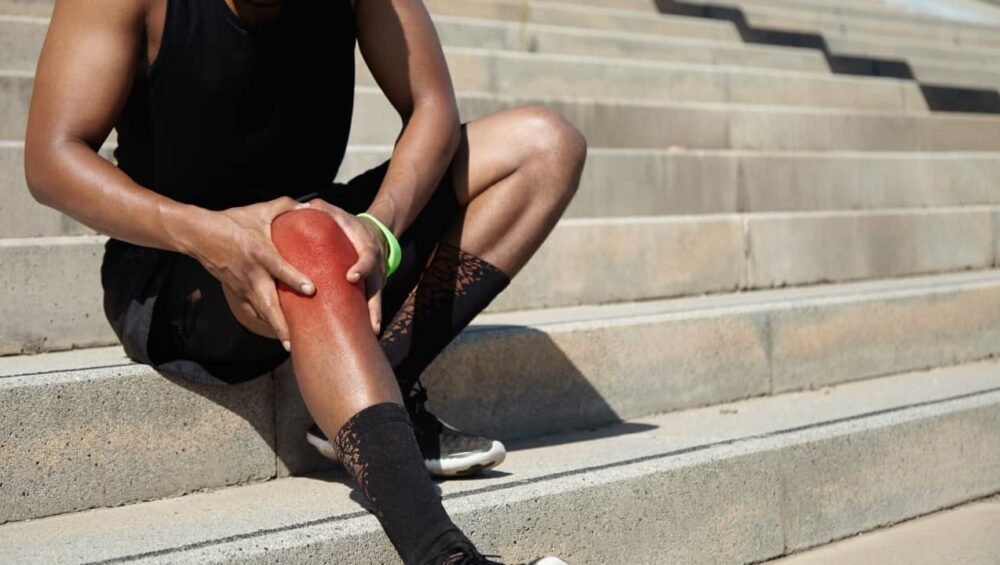Did you know that above 25% of adults are facing the problem of knee pain, which affects their daily life activities? Knee pain causes include overuse, arthritis, and injuries. Imagine playing basketball that involves jumping. It can trigger your knee discomfort. Or didn’t you go for a walk due to your knee discomfort? It’s a reality for millions worldwide.
Knee soreness is a not-so-bothered thing that many people face no matter how old they are. This condition hampers your daily routine; for example, when walking up the stairs, walking, or standing for a long time, it is hard and uncomfortable. The knee joint is the connective part of a group of bones, muscles, ligaments, and cartilage. It makes motion and body support incomprehensible yet is very delicate and difficult to make it a complex structure.
Any such part that is injured or overused gives rise to pain in the knee. An informed recital of pain’s causes, symptoms, and its treatments can help the patient make sensible decisions about their recovery and prevention of any similar incidents in the future.
Knee Pain Causes by Several Factors
Will you walk enough? One of the biggest mistakes patients with patellar pain make is to use their knees less. Knee discomfort can stem from various acute injuries, chronic conditions, structural issues or systemic disease that has been ongoing for some time already.
1. Overuse
Physical work puts knee joints under strain from repetitive motions like crawling on hands and knees. Overuse happens when knee joints are repeatedly strained by activities such as running, jumping, and climbing without adequate recovery time. Constant stress causes irritation swelling and minor injuries to surrounding muscles tendons and tissues.
Overuse injuries often include runner’s knee pain felt behind the kneecap jumper’s knee pain just below the kneecap and iliotibial band syndrome causing discomfort on the outer knee.
Overuse often causes doing too much physical activity quickly, using improper techniques, and having muscle imbalances and weaknesses. Can happen if someone doesn’t rest enough between activities. Prevent overuse injuries; increase activity levels gradually; use correct techniques. Strengthen muscles around the knee and take rest days to let the body recover.
Overuse causes knee pain; resting, icing the area, and reducing activity can help. However, if pain doesn’t improve, it is important to see a doctor to rule out more serious issues.
2. Injuries
Knee pain is usually caused by accidents. The knee is a swarming joint that holds the body’s weight and allows it to move, which makes it vulnerable to injury. It is possible that your knee will be twisted during playing sports. A fall on your knee may be awkward landing, or a simple day-to-day activity that just harms it.
Most of the time, these injuries occur suddenly, like tearing a ligament (such as an ACL tear), and then swelling and pain appear. These injuries are common in athletes who take sharp turns or make sudden stops. On the other hand, the meniscus tear is when a person has the cartilage in his or her knee damaged by twisting or lifting stuff that is too heavy. One can undergo minor injuries such as a sprain or strain from the knee joint caused by overworking. If they are not treated right away, they can result in pain and limitation of movement.
However, these are some of the most injured parts of a knee and can lead to severe pain, swelling, and discomfort while walking or even making simple day-to-day movements. This injury is especially common in individuals playing sports, possibly caused by abrupt landing, sudden twitches, or impact. Knee pain’s a profound outcome of various traumas like falls or car accidents or sports injuries or knee sprains that disrupt your knee’s mechanical focal point.
3. Arthritis
Knee pain causes stiffness creeping up with age might be a warning sign of osteoarthritis slowly taking hold. Morning stiffness frequently gets worse due to prolonged inactivity and this type of pain. Osteoarthritis is basically a chronic joint condition where cartilage in the knee degenerates. Old people frequently experience inflexibility and pain due to knee cartilage degradation.
This is the most common kind of it, osteoarthritis, among the most common types of Arthritis. It can be when the cushion in your knee that should be soft and resilient as cartilage slips over time. As a consequence of this lack of padding, the bones in your knee might abrade each other. It leads to pain, swelling, and stiffness. It is a continuous process that is going on with ageing, but it is also caused by being overweight and having a past injury to your knee.
Rheumatoid arthritis bears resemblance to the aforementioned condition, being one kind of osteoarthritis albeit vastly distinct. An autoimmune disorder, the body’s immune system mistakenly attacks the knee joint’s covering, precipitating pain and swelling, due to a freak misfire of sorts.
On your successful treatment of this condition, the doctors will be forced to prescribe medications that make the crystals from forming. Your condition will depend on controlling your diet and on lowering your body weight.
Problems With How the Knee Works
Sometimes, it is how the knee is moving that creates pains in the knee. For example, when your kneecap gets out of its normal place, i.e., a dislocated kneecap, it can bother you so much that it may become impossible to straighten your leg. In addition, iliotibial (IT) band syndrome is another issue in which a band of tissue on the side of your knee edge gets irritated, often because of running too much or cycling a lot.
Another reason for knee pain causes may be the way you walk. If your feet are inwardly turned, muscles in the plank and abductor muscles are shortened, and the arch is flattened. The result is not only that these problems don’t look serious at first, but they also start growing into bigger issues.
How to Resolve Knee Ache
Patellar pain can come and go. For example, many people feel pain in different parts of the day. You can feel more pain in the morning when you wake up; sometimes it is common to feel knee pain at night, especially if you were physically active earlier that day. Try these exercises for arthritis.
Staying active is good for tackling knee discomfort. Regular exercise strengthens muscles surrounding the knee, providing superior support and reducing stress on the joint.

RICE (rest, ice, compression, elevation) Method
The RICE method for arthritic knee entails stopping physical activity causing pain to prevent exacerbating the injury. Apply an ice pack wrapped in a towel directly on the knee for 10-15 minutes, avoiding direct skin contact somehow.
Rest and Protect Your Knee
Stop your knee from moving to prevent additional damage. Avoid activities that increase the pain and instead consider utilising a knee brace or compression sleeve for extra support. Your leg positioning on a pillow can minimise swelling and increase your comfort level. It does not take a lot of effort for these applications to work, as the knee will get better on its own without them.
Gentle Exercises and Stretches
Gentle exercises and stretches can be super beneficial. Evidence suggests that strengthening muscles around your knee helps reduce pain and prevents it from coming back. Don’t rush into high-impact exercises; start with low-key stuff like leg raises and stretches or activities such as swimming or cycling. Muscle-building exercises such as leg raises, stretches, and activities like swimming and cycling are your only options. Since the joints will dislodge if you do not protect your knee from the pressure of your own weight.
Maintain a Healthy Weight
Being overweight is one of the reasons for excess load on your knees and therefore more pain. To get results, try a well-balanced diet and regular exercises. This way, you can obtain and maintain a strong and healthy weight, which will in turn reduce the pressure on your joints and, in the end, enhance your capability of movement.
Topical Creams for Knee Inflammation
Looking for a simpler alternative to tough workouts? Knee pain creams are convenient and non-invasive. They’re easy to use and help with patellar pain by reducing inflammation.

Among the most well-liked means of treating knee ache is the use of topical creams sold in drugstores and balms. The main advantage of these products is that the treatment is local and therefore avoids the abuse of body drugs. They are a great way to provide direct pain relief by killing inflammation in the area of the body with the problem. It is because they are composed of certain medically useful properties and fixing mechanisms that are related to each other.
Tip: If knee pain stems from an injury or condition such as arthritis, verify with your healthcare provider that gentle exercise is safe for your particular ailment first.
Knee Pads
Use knee pads for physical activities; wear a knee brace if you are recovering from an injury or participating in high-risk sports.
Footwear Matters
Wearing soft footwear can really help reduce knee soreness. Opt for shoes featuring decent arch support plus shock-absorbing soles that take pressure off your knees somehow. Hence you feel comfortable. Make sure your shoes fit well and provide maximum balance for daily use. Avoid high heels and shoes without support, as they can ruin your knees and make the pain worse.
Related Pick: Types of Massage for Arthritis
Consult a doctor if the pain worsens. Remember, your knees are vital for daily movement; caring for them ensures an active, pain-free tomorrow. Integrating self-care practices with knowledgeable assistance will allow one to repossess their knee health and therefore pave the way to an active, pain-free life.


